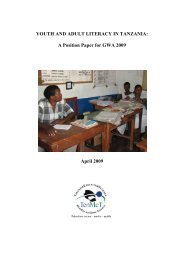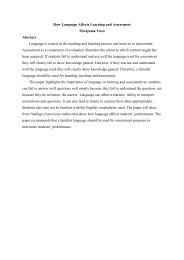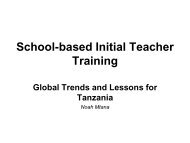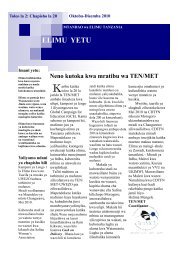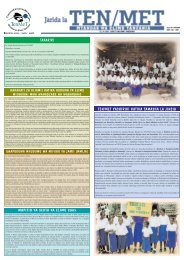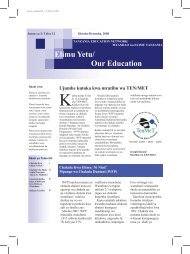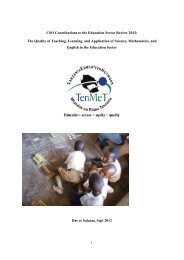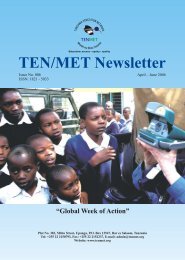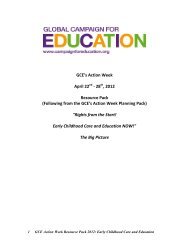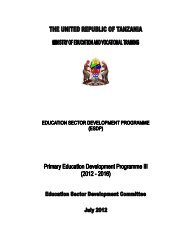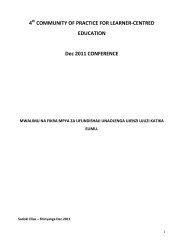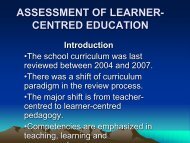A Simple Guide to Working with Finances in Education - Tanzania ...
A Simple Guide to Working with Finances in Education - Tanzania ...
A Simple Guide to Working with Finances in Education - Tanzania ...
Create successful ePaper yourself
Turn your PDF publications into a flip-book with our unique Google optimized e-Paper software.
The basic <strong>to</strong>ols for budget analysis are these: Share of Gross Domestic Product Percentage change between one year and another Annual Average Growth rates for expenditure on education or other sec<strong>to</strong>rs Real growth rates (<strong>in</strong> other words adjusted <strong>to</strong> take <strong>in</strong>flation <strong>in</strong><strong>to</strong> account) Per capita spend<strong>in</strong>g Comparisons <strong>with</strong> previous years’ spend<strong>in</strong>g.The follow<strong>in</strong>g pages show the k<strong>in</strong>ds of calculation that can be used, us<strong>in</strong>g data from<strong>Tanzania</strong>’s Poverty Reduction Strategy. You can try out these calculations, and theanswers are given at the back of this booklet.Look at the follow<strong>in</strong>g data for education spend<strong>in</strong>g <strong>in</strong> <strong>Tanzania</strong>, measured <strong>in</strong>billion Tshill<strong>in</strong>gs:A B C D E F G1 1999/00 2000/01 2001/02 2002/03 2003/04 Av. Growthrate:2001/02 -2003/042 Nom<strong>in</strong>al 162 248 348 433 4873 Real4 RealGrowth rate5 Total * 292 468 737 953 10626 Total Real*Defla<strong>to</strong>r 4 0.943 1 1.05 1.09515 1.141146*This refers <strong>to</strong> <strong>to</strong>tal spend<strong>in</strong>g on the priority sec<strong>to</strong>rs identified by <strong>Tanzania</strong>’s PovertyReduction Strategy: education, health, agriculture, water, roads, HIV/AIDS4 Defla<strong>to</strong>rs are derived figures related <strong>to</strong> <strong>in</strong>flation. For example if there is a general <strong>in</strong>crease <strong>in</strong> prices of 4.5%from 2002 <strong>to</strong> 2003, and it takes TZS 200 <strong>to</strong> buy a loaf of bread <strong>in</strong> 2002, then <strong>in</strong> 2003 it will cost 4.5% moreor (TZS 200 x 1.045 =TZS 209) – the defla<strong>to</strong>r is 1.045. When defla<strong>to</strong>rs are derived, it is first necessary <strong>to</strong>choose a base year <strong>to</strong> which we will compare <strong>with</strong> all other years. In economics and budget analysis, it iscus<strong>to</strong>mary <strong>to</strong> choose the previous fiscal year as the base year. The defla<strong>to</strong>r for the base year is def<strong>in</strong>ed as 1.In practice, you do not need <strong>to</strong> calculate the defla<strong>to</strong>rs as they are normally provided by the government,specifically the M<strong>in</strong>istry of F<strong>in</strong>ance. Defla<strong>to</strong>rs can also be obta<strong>in</strong>ed from PER documents and the World Bank.When do<strong>in</strong>g budget analysis, it is recommended <strong>to</strong> use the defla<strong>to</strong>r provided by the government of therespective country. Whichever defla<strong>to</strong>r figures you use, it is important <strong>to</strong> state the source.26



